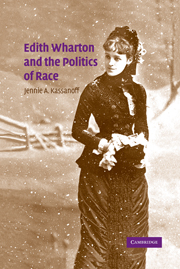Book contents
- Frontmatter
- Contents
- Acknowledgements
- Introduction
- 1 Invaders and Aborigines: playing Indian in the Land of Letters
- 2 “The real Lily Bart”: staging race in The House of Mirth
- 3 “A close corporation”: the body and the machine in The Fruit of the Tree
- 4 The Age of Experience: pragmatism, the Titanic and The Reef
- 5 Charity begins at home: Summer and the erotic tourist
- 6 Coda: The Age of Innocence and the Cesnola controversy
- Notes
- Bibliography
- Index
6 - Coda: The Age of Innocence and the Cesnola controversy
Published online by Cambridge University Press: 22 September 2009
- Frontmatter
- Contents
- Acknowledgements
- Introduction
- 1 Invaders and Aborigines: playing Indian in the Land of Letters
- 2 “The real Lily Bart”: staging race in The House of Mirth
- 3 “A close corporation”: the body and the machine in The Fruit of the Tree
- 4 The Age of Experience: pragmatism, the Titanic and The Reef
- 5 Charity begins at home: Summer and the erotic tourist
- 6 Coda: The Age of Innocence and the Cesnola controversy
- Notes
- Bibliography
- Index
Summary
Near the end of The Age of Innocence (1920), would-be lovers Newland Archer and Ellen Olenska seek a private colloquy in the new Metropolitan Museum of Art. “It's odd … I never came here before,” Ellen remarks, as the couple stroll through “the queer wilderness of cast-iron and encaustic tiles.” “Ah well –,” Archer replies. “Some day, I suppose, it will be a great Museum” (258). In a city where “there are no churches … no monuments,” the Metropolitan seems to offer the adulterous pair temporary refuge from the prying eyes of Old New Yorkers for whom “any less systematized and affluent existence” than their own seems “unreal and precarious” (257, 183). Archer, who has grown to feel increasingly alienated from this “hieroglyphic world, where the real thing was never said or done or even thought, but only represented by a set of arbitrary signs,” seeks out the new museum as a haven of authenticity – a place where his “real life” with Ellen can supplant his “sham one” as May Welland's respectable husband (41, 220, 203).
Indeed, Archer's illicit passion for May's cousin Ellen, the estranged wife of a corrupt European count, has dangerously unsettled his own precarious relationship to the real. “The things that had filled his days seemed now like a nursery parody of life, or like the wrangles of medieval schoolmen over metaphysical terms that nobody had ever understood” (153).
- Type
- Chapter
- Information
- Edith Wharton and the Politics of Race , pp. 153 - 165Publisher: Cambridge University PressPrint publication year: 2004

